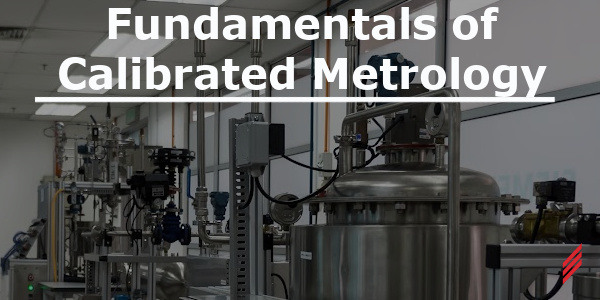Fundamentals of Calibrated Metrology
by Shane Hamlin on Sep 19, 2024 10:30:00 AM

In my first blog, I introduced how important it is for multiple types of industries to keep all their equipment calibrated for success. I talked about my background and how I found that using calibrated equipment made the end results better for myself, the client, and bottom line. I will continue to dive deeper into this with upcoming blogs. With this blog, I will explain exactly what calibrations and metrology are, and how it can help you and your business. I discussed my current role with Hallam-ICS and how it has shown me over the years what I knew to be true already, having calibrated and accurately reading equipment makes for a better product, which ultimately leads to client satisfaction.
Calibration
Calibration is defined as the process of comparing the measurement of equipment or an instrument, known as the device under test, to a known standard to determine its accuracy. It is a process of configuring a result for a sample within an acceptable range. This ensures that the equipment provides precise and reliable measurements. If a discrepancy is found, a qualified technician can adjust the equipment to correct these inconsistencies. Using metrology methods, we can see how calibrations are one aspect to eliminating or minimizing factors that cause inaccurate measurements. It is fundamental to all businesses to have calibrated equipment, which is essential to producing a consistent and high-quality product.
Metrology
Metrology is a broader scientific study of measurement. It encompasses the development of measuring standards, techniques, and tools to ensure accuracy and consistency across various fields. It is essential in all fields, but more importantly in manufacturing, healthcare, environmental monitoring, and scientific research where precise measurements are critical. Here are the key aspects of metrology.
The most important key to metrology is calibration, as it helps to maintain the reliability of measurements by ensuring instruments are properly calibrated. Comparing the measurements of equipment to a known reference ensures its accuracy. As earlier discussed, this is crucial to ensuring that the device you are testing is both accurate and consistent. Having properly calibrated equipment will give you peace of mind, knowing you have a quality product.
Measurement Standards
Measurement standards are another key aspect to metrology. Units of measurement (meters, grams, seconds…) are defined for establishing and maintaining reference standards. Measurement standards are often very tangible physical objects, which help to embody a quantity that is consistent across all calibrations. This ensures consistency with measurements across your equipment with a standardized reference. By having this consistency, your measurements can be traced to the national standard.
Traceability
The next area of metrology to discuss is traceability, which ensures that the measurements can be traced back to a standard of origin. These standards should have an unbroken chain to national or international standards for comparison. This means every standard used has been calibrated and traced to another testing standard until they have reached the highest level of checks and balances with the National Institute of Standards and Technology (NIST) or the International Organization for Standardization (ISO).
Uncertainty
Another aspect that needs to be discussed is uncertainty. Uncertainty is the quantifying of doubt that can occur from measurements, this helps to understand the reliability of your measurements. It is the range of possible values within which the actual value of the measurement lies. In simple terms it is the doubt of the measurements, it tells you how reliable the measurement is. Every measurement has some level of doubt, but knowing this doubt allows us to know if our measurements are good enough for an instrument’s usage. This ensures that, as the owner of the equipment, you can feel assured in the calibrations performed. It gives you a defined and quantified range for your product, that you can deliver to your customers with confidence.
Quality Assurance
Last, but not least, let us discuss the quality assurance that metrology can give you. We have touched upon this a few times throughout the blog, but let’s look at how it can give your reassurance. Implementing the right processes and procedures will provide accuracy and consistency of your equipment, allows you to know your protecting your product or process. Quality assurance ensures that products and services are consistently meeting and hopefully exceeding your customers’ expectations. By setting clear quality goals, defining criteria, and implementing control measures, metrology and calibrations can ensure that your deliverables are of the highest quality. You will have reliable products, which when efficiently made, will please your customers and could help your profits.
I hope this gives you some insight into what exactly calibrations and overall metrology are. It provides a traceable system of checks and balances for your equipment, allowing your business to run as you intend. Implementing the right processes ensures confidence in your product, satisfies your clients, and can boost your bottom line.
About the Author
From his diverse work experiences to his current role with Hallam-ICS, Shane has learned the critical importance of not just having the right tools but properly calibrated tools to get a job done right. Having worked across various industries has given him a unique perspective on the importance of precision. In this blog, he will show that no matter what profession you work in, the difference between a job done and a job done well stems from the calibrations of your tools.
Read My Hallam Story
About Hallam-ICS
Hallam-ICS is an engineering and automation company that designs MEP systems for facilities and plants, engineers control and automation solutions, and ensures safety and regulatory compliance through arc flash studies, commissioning, and validation. Our offices are located in Massachusetts, Connecticut, New York, Vermont and North Carolina and our projects take us world-wide.
You May Also Like
These Related Stories

What Does Employee Ownership Mean to an Employee?

Blind Spot Animal Sanctuary: Emus, Alpacas, Goats, Pigs, and More!



No Comments Yet
Let us know what you think